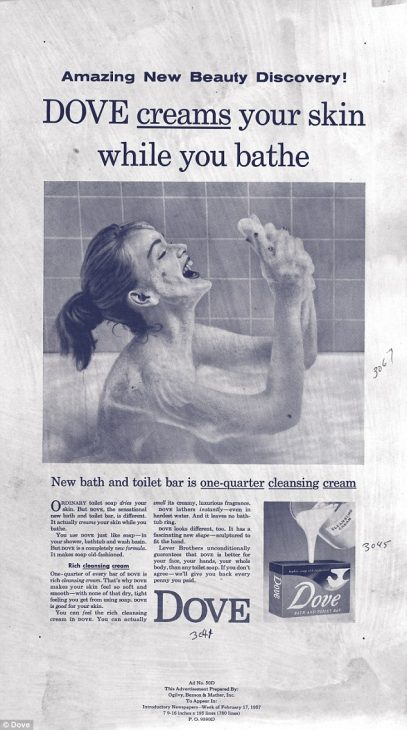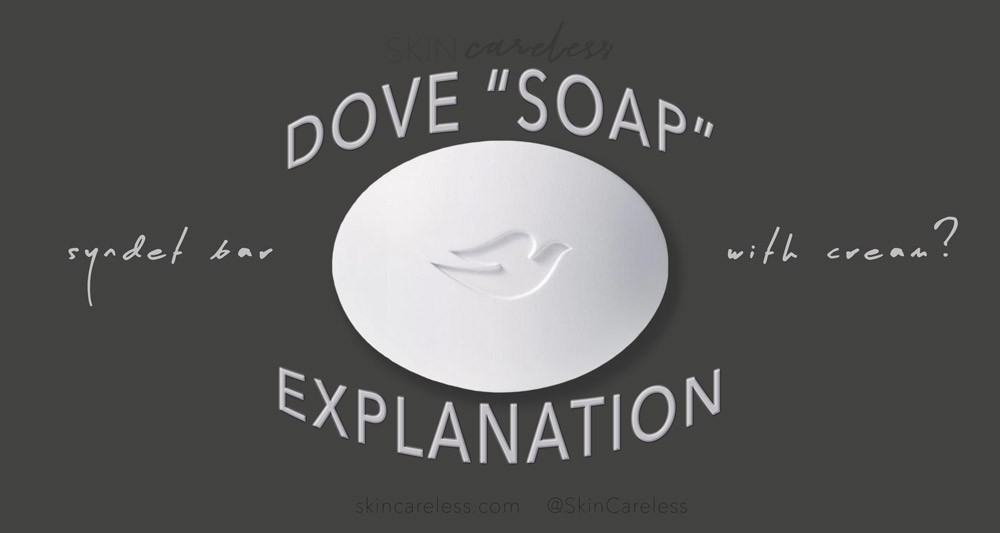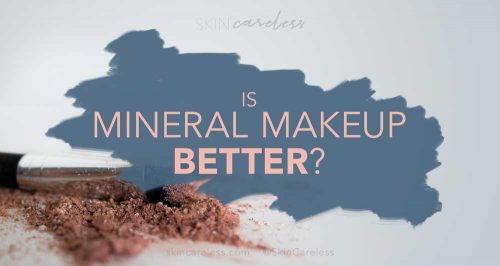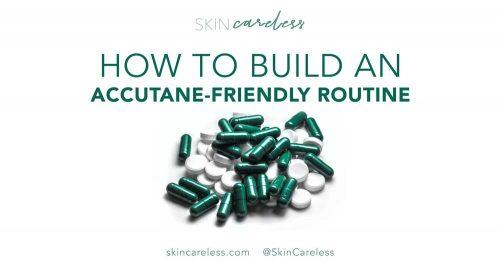It’s the most popular and ubiquitous bar of soap in the world. Sorry, scratch that, the most popular and ubiquitous ‘beauty bar’ in the world.
You’d be hard-pressed to find anyone on the globe who isn’t aware of Dove and, most especially, their Original Beauty Cream Bar/White Beauty Bar. The blue and gold packaging is simple and yet distinctive, featuring a curved white bar imprinted with the iconic dove logo. And given it rests on billions of shelves in nearly every kind of store you can think of worldwide, we’ve likely all grown up considering it a given. Maybe you used it as a child. Maybe you use it now. Or maybe you’ve never tried it, preferring instead to skip soap in favour of liquid cleansers.
But that’s the thing; Dove “soap” isn’t just soap as you know it at all – and the differences actually make it a great cleanser choice for anyone – especially those struggling with acne. Let’s dive into the history of this enigmatic little cleansing product and how you can use it in your skin care routine.
History of the Dove Beauty Bar
Before Dove, there were only two options for face washing: soap or cleansing cream.
Soap is the result of when you mix oils or fats and an incredibly alkaline solution, usually lye (sodium hydroxide) to cause a chemical reaction that leaves behind salts. These salts are what makes soap soap! They break surface tensions, allowing water and oil to mix where they usually would repel. Thus, the water can get right down to the surface of what it’s cleansing and break free any grease and send it down the drain. Unfortunately, the bar of soap you’re left with still retains that high pH from the lye – which is what makes soap overly alkaline and thus problematic.
And cleansing cream – despite its name – lacked cleansing abilities, because the oily formula did not emulsify with water and therefore could not be rinsed, only wiped off. It was really just a moisturiser or balm used to break down makeup.
But in the years leading up to the 1950s, companies had been developing synthetic ingredients that gave soap’s cleansing effect, without the saponification process. These non-soap detergents were still relatively new and unknown, and only just beginning to gain popularity. They were mainly limited to laundry products at the time, as the formulations were still incredibly stripping and strong.
So as it stood, in the 1950s faces were truly left out of the cleansing revolution – that is, until Dove released its beauty bar in 1957. With pH-balanced synthetic cleansing agents (detergents), it truly did revolutionise the skin cleansing world. It wasn’t the first of its kind, but it was arguably the best.

Yet as cleansing liquids and detergents have become readily available and formulas have become more complex, we’ve started to refer to soaps and detergents interchangeably. “Soap = detergent = cleanser = wash” to many people. Truly, both soap and detergent are cleansers, but soap is not detergent and vice versa.
Despite this, the Dove beauty bars have colloquially become known as ‘Dove soap’.
What Dove claims about its beauty bar
Dove’s beauty bar set itself apart, with campaigns proclaiming it “not-soap” and specifically being advertised for the skin and face. It portrays itself as highly moisturising and gentle. At the time, dryness was a major concern for consumers (more so than acne, it seems).
From the beginning – and to this day – Dove claims its bar contains ‘1/4 moisturising cream’. At first glance that seems innocuous enough, but any knowledge of soapmaking will have you wondering – how the heck does it contain cream? And the answer is – it doesn’t really.
Ingredients
Sodium Lauroyl Isethionate, Stearic Acid, Sodium Tallowate Or Sodium Palmitate, Lauric Acid, Sodium Isethionate, Water, Sodium Stearate, Cocamidopropyl Betaine, Sodium Cocoate Or Sodium Palm Kernelate, Fragrance, Sodium Chloride, Tetrasodium Edta, Tetrasodium Etidronate, Titanium Dioxide (Ci 77891).
The first thing I notice is that this is simply a basic cleansing bar, with very little else other than those cleansing ingredients.
Detergents
The main cleansing ingredient – a detergent, Sodium Lauroyl Isethionate – isn’t one that has to go through saponification. Thus, Dove is a ‘syndet’ bar, standing for ‘synthetic detergent’ bar (doesn’t quite roll off the tongue like ‘beauty bar’, does it?).
Sodium Lauroyl Isethionate, Sodium Isethionate, and Cocamidopropyl Betaine all synthetic detergents/surfactants. They are cleansers, but they are not soap!
Soaps
However, very interestingly, Sodium Tallowate, Sodium Palmitate, Sodium Stearate, Sodium Cocoate, Sodium Palm Kernelate (some of which appear interchangeably as pairs on the ingredients lists) ARE soaps. They are the resulting salts made from mixing a variety of different oils/fats (beef fat, palm oil, coconut oil, and palm kernel oil) with lye.
Miscellaneous
Stearic acid and Lauric acid are free fatty acids created from Dove’s specific (and patented) way processing of coconut oil into soap.
Fragrance – not great, but often hard to avoid in the skin care world. Better in a cleanser than any other product, where it’ll be washed off right away.
The Tetrasodiums are in there to help the product release from the skin and basin and rinse clean, without leaving behind soap scum.
Finally, Titanium Dioxide makes the bar white.
Is Dove soap?!
So a better description of this product would be a HYBRID or COMBINATION “syndet” (synthetic detergent) cleansing bar. It does contain soap, but uses other cleansing ingredients primarily so as to minimise the alkalinity of the final product while still getting the excellent degreasing capabilities and other benefits of soap.
There’s more though: Dove also has those free fatty acids laying around. This is thanks to a process called superfatting, when excess oils/fats and an acid are added to the formula to encourage extra fatty acids from the oils to be left over in the bar. This counteracts the natural alkalinity of soap and also contributes to the natural moisture barrier. Thus making the product more hydrating, less likely to go rancid, and have a better pH. Based on what appears to be the original patent and formulation process I found for Dove’s bar, the end result is about 10% superfatted free acids. It’s nothing special or too unique – look up ‘superfatting‘ to learn more – but this particular formula and result is patented.
This is probably how the very creative claim ‘1/4 moisturising cream’ comes about – that’s likely based on the amount of free fatty acids, along with water and other substances that are present in this bar which are also present in a cream. (It’s kind of like saying nachos are 50% pizza, because of the total amount of pizza ingredients present, like cheese, flour in the tortilla chips, spices and salt.)
For a better explanation of the ingredients of this combination syndet bar, check out this soaper’s breakdown of the ingredients and guide to making it at home.
What makes the Dove Beauty Bar good for acne?
Now, we’ve spoken a lot about the history of Dove and why it may or may not be considered soap.
Soap or not soap, regardless, Dove is a very simple, reliable cleanser. If you’re going to use a bar of cleanser, it’s a good one to choose. And for some people, Dove bars may actually be helpful in clearing up their skin. Why?
It’s pH neutral
Being a 7 on the pH scale makes this product still more alkaline than skin (which is 5-6), but better than regular soap. The acidity is thanks to the moisturising fatty acids, or more specifically the initial acid added to the formula to prompt their development in the final bar. The final bar doesn’t affect your skin’s pH much, and thus doesn’t increase the risk of infection and irritation that comes along with disruption the natural acid mantle. If you’ve been using high pH cleansers until now a switch to this will definitely be positive.
It’s simple
Less is more when it comes to acne prone skin. The fewer ingredients, the lower the risk of reaction and breakouts. A short ingredients list is a good ingredients list most of the time, and this hits that spot, being very plain and inert. If you are unlucky and do have a sensitivity to certain ingredients, it shouldn’t be difficult to pinpoint what’s causing the problems.
It contains Lauric acid
Lauric acid, one of the aforementioned saturated fatty acids in this bar, as known for being antimicrobial, and shows promise as an acne treatment. As part of the natural moisturising factor, it’s also not drying like many other common acne-fighting ingredients. It’s thought to be potentially irritating for very sensitive peeps, so keep an eye out.
Basically, Dove bars have got a balance of the moisturising benefits of fatty acids and the cleansing power of soap and synthetic detergents, all without comedogenicity or pH issues. Sounds nice! All this makes it a great choice of cleanser for acne sufferers.
My test of Dove’s beauty bar as a cleanser
This is a ride full of twists and turns – more than you’d expect in an article about soap – wait, not-soap.
Dove “not-(just)-soap” is no longer revolutionary – syndet and combination ‘soap’ bars are available everywhere now. But it remains the first, one of the more affordable, accessible and well-known.
I feel like I’ve seen this product so much and it’s imprinted in my brain that I would have had to have used it at some point by now, but you know I can’t say for sure that I have.
I had very sensitive skin as a child, and suffered with terrible eczema. I was instructed to avoid soap like the plague and like the good girl I was so I did. So I’ve been about 15 years without touching a bar of soap (don’t worry, I used liquid body soap (detergent, not real soap) instead every day!). Interestingly enough, my absolute favourite ride-or-die for years and years has also been Dove brand. Specifically, this exfoliating version. The lather is creamy, and it leaves my skin fairly moisturised and happy. But best of all smelling great. Not like a strong fragrance, but my actual skin reacted with the product and took on a sweet lovely smell that lasted hours and hours.
My distaste for soap is fairly well-known. And until now, I lumped this bar with all the other soaps. But after all this research into the original beauty bar, and seeing the promise and all at the cost of a couple dollars a bar, I wondered – will I like it? Only one way to find out!
On my body
Using a bar to cleanse is foreign to me. I gave u trying to rub it on my skin where the foam just wasn’t enough, and instead applied it to a loofah and used that to foam it up.
While still in the shower I was met with a bit of that familiar friction-filed, freshly-soaped body feeling I’d grown to associate with dry skin and hate. Not feeling positive.
But I was shocked to find my usually parched skin – after towelling dry – was feeling creamy and hydrated. Not at all what I’d been used to, requiring a lotion right after my shower every time. It felt interestingly soft, silky and great! And it smelled awesome. I’m a sucker for clean smells and this has a similar lingering effect to my beloved body wash.
On my face
I’m going to be brave and try using this as a face cleanser too (eek!) for the next little while, in hopes of finally finding my holy grail cleanser. I’ll report back.
Update: This made a surprisingly nice cleanser, It’s low-foaming, subtly scented, and convenient. I didn’t have any new breakouts, but my stubborn skin didn’t completely clear up either. I don’t love the bar format in terms of countertop cleanliness, but it’s definitely going in my travel bag next time I’m heading on a trip, because it’s so multipurpose and impossible to spill! Definitely happy with how it worked on my face.
If you want to try it along with me, you can get yourselves a bar just about everywhere. Watch as you see it everywhere you turn now! But you can also pop it into your next amazon basket from here.






A few years ago I used to cleanse my face with a bar of dove soap every day and it worked well for me.
So the anti-fungal pills kept your Folliculitis away? My face looks exactly how yours used to look. Every once in awhile when my skin really doesn’t like something it will be covered in the small white pustules. Most of the time I have many of the small white head pustules every day and no matter what I do I wake up with new ones. I have been to two dermatologists and they both told me it was Perioral Dermatitis but after seeing your pictures I’m thinking it’s Folliculitis. I’m so confused!!!
Hey! Yes, since the course of antibiotics my skin’s never gotten back to the stage it was in my folliculitis post. Not exactly sure if it was environment or a trigger that set it off, but it’s not happened again. Keep in mind that folliculitis can be fungal, bacterial, or an allergic reaction in disguise! Maybe it’s time to explore antibiotics, antifungals or cutting out all your skin care products to rule out allergy. It’s so confusing, I know. Good luck!
[…] All soap is made using a combination of oils and lye – a highly alkaline hydroxide usually produced from ashes. Mixed together, they form a product which cures over time, and the resulting solid suds up on contact with water, with an incredible and counter-intuitive ability to cut through the skin’s oils. I’ve actually devoted a whole post to the science of soap and why synthetic alternatives are often…. […]
[…] using on your skin – like cleansers, toners and moisturisers – are pH balanced. Some do this nicely, and others not so […]